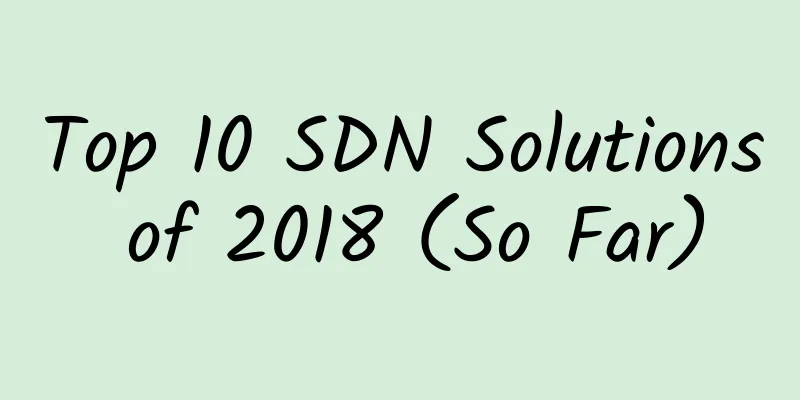Top 10 SDN Solutions of 2018 (So Far)

|
Software is the front and center of the network world, and customers need more programmable, flexible and lower-cost network solutions. With the increasing adoption of cloud-based services, the need to reduce the complexity of data centers has gradually increased, which has promoted the development of technologies such as software-defined wide area networks and intent-based networks. According to a research report by Global Market Insights, the global software-defined network solutions and services market is expected to grow at a compound annual growth rate (CAGR) of 54% in the next few years, reaching US$88 billion by 2024.
This article introduces the ten most popular software-defined networking technologies on the market so far in 2018. 1. Apstra AOS 2.2 Apstra this year launched a new version of its intent-based networking AOS software, whose features include intent-based analytics. AOS 2.2 is a turnkey solution that allows users to fully automate data center operations across the entire network regardless of the customer's vendor mix, allowing the Menlo Park-based startup technology based on the development project to automatically prevent and repair network outages. The new version embeds big data analytics, allowing operators to specify how they want the network to operate and continuously verify the operator's intent when abnormal conditions such as anomalies are detected. AOS 2.2 currently supports multi-tenancy and enhanced inter-rack Layer 2 connectivity via Ethernet VPN to provide a scalable control plane. 2. Big Switch’s SDN Cloud Fabric Big Switch Networks this year launched new support for VMware vSAN, Dell EMC ScaleIO and Nutanix hyperconverged solutions for its Big Cloud Fabric SDN switching fabric. Big Switch's data center software-defined networking solution provides network automation and visibility of cloud-native applications and can complete fabric upgrades in minutes. The solution leverages an SDN-based leaf/spine fabric and open network hardware to quickly deliver networks for scale-out deployments and provide high performance for large clusters. The Santa Clara, California-based vendor's Big Cloud Fabric has many successful use cases involving hyperconverged infrastructure, containerized workloads, OpenStack and low-latency VDI workloads. 3. Cisco Intent-Based Networking Cisco invested heavily in its intent-based networking platform in 2018, which now has 5,800 customers. Cisco's intent-based strategy uses software to automate network policy and management, and is moving to a more open software-defined architecture, said CEO Chuck Robbins. The San Jose, California-based networking giant is developing DNA Center, the control and management platform for intent-based networking, an open platform that allows partners to develop custom applications and provide customers with more SDN solutions. Cisco also launched two new software systems in 2018, Network Assurance Engine and DNA Center Assurance, to enhance the platform's SDN capabilities. 4. Dell EMC VEP 4600 Dell EMC launched its x-86-based virtual edge platform network solution this year, using Intel's Xeon D-2100 processor to connect the edge to the cloud. The VEP 4600 is a general-purpose virtual network CPE that Dell calls an ideal access platform for SD-WAN and virtual network functions such as routing and deep packet inspection. The infrastructure giant, headquartered in Round Rock, Texas, has verified three SD-WAN solutions on the platform: VMware's Velocloud, Silver Peak and Versa Networks. The VEP 4600 went on sale in April and is priced at $1,500 in the United States. 5. HPE Aruba SD-Branch In June, HPE Aruba launched SD-Branch, which combines new branch and front-end gateways with existing HPE Aruba technologies (including ClearPass policy management) to form an integrated SD-WAN, WLAN, LAN and security solution. The new Aruba branch gateways are purpose-built using internally developed software with integration in mind. These gateways are integrated with Aruba's recently enhanced Aruba Central cloud management platform to provide a single point for SD-WAN, wired and wireless networks, and policy enforcement. Aruba said that SD-Branch enables customers to manage more branches with fewer staff while leveraging a consistent approach to security and compliance across locations. 6. Juniper Contrail SD-WAN Juniper's Contrail SD-WAN provides a multi-cloud solution that enables customers to automate the WAN edge across virtual cloud endpoints and local firewalls or CPE platforms. The solution uses Juniper's Contrail Service Orchestration to design, protect, automate and run the entire service lifecycle of Juniper network products such as routers, gateways and other network platforms. In June, Juniper enhanced Contrail SD-WAN capabilities, adding support for fine-grained application quality of experience (AppQoE), providing visibility and management of individual application performance for more than 3,700 applications including Microsoft Outlook and Skype for Business. Customers can now use Contrail's orchestration management policies to adjust the performance of applications between branch offices. 7. Nutanix Flow As part of Nutanix's 2018 strategy to become a software-only vendor, the hyperconverged infrastructure pioneer launched a new software-defined networking product designed for multi-cloud environments: Nutanix Flow. Flow provides application-centric security to protect against internal and external threats that are not detected by traditional perimeter-oriented security products. The solution includes network delivery and management automation, as well as native micro-segmentation services that manage traffic between individual applications to protect against threats. Nutanix, headquartered in San Jose, California, has embedded Flow into its flagship enterprise cloud operating system. 8. Silver Peak Unity EdgeConnect SD-WAN Silver Peak's Unity EdgeConnect provides predictable application performance and a seamless migration path to SD-WAN, designed to reduce WAN costs. Unity EdgeConnect features dynamic path control, edge-to-edge data security, and real-time updates for the best path to reach software-as-a-service applications. In June, Silver Peak improved its SD-WAN solution by introducing segmentation and security service chaining. These new features enable distributed enterprises to centrally segment users, applications, and WAN services into security zones and automate application traffic control across LANs and WANs. For enterprises with multi-vendor security architectures, EdgeConnect provides seamless drag-and-drop service chaining for security infrastructure and services. 9. VMware NSX Cloud In 2018, VMware launched the new NSX Cloud as part of the company's new virtual cloud network strategy. VMware's NSX Cloud provides consistent networking and security for applications running in VMware-based private data centers and native public clouds. The new product has native controls for Microsoft Azure and AWS. NSX Cloud is designed to address the challenges of using multiple public clouds, such as inconsistent policies and constructs across clouds, manual operations that require policies for each cloud, and operational tools specific to each public cloud. 10. VMware NSX SD-WAN VMware acquired VeloCloud at the end of 2017 and became a leader in the SD-WAN market. In May of this year, VMware launched VeloCloud's new NSX SD-WAN, which provides reliable application performance from the data center to the branch office to the cloud through NSX data center integration, and provides end-to-end segmentation. NSX SD-WAN supports cloud and application performance, including full visibility, metrics and control of all devices and user endpoints, as well as simplified activation and automatic connection. VeloCloud's NSX SD-WAN is part of VMware's Virtual Cloud Network strategy, which got VMware CEO Pat Gelsinger talking at Dell Technologies World. "This is VMware's vision for the future of networking: a pervasive software layer from the data center to the cloud to the edge — enabling users to connect and protect data wherever it resides; embedding security directly into the platform; and enabling control and automation," Gelsinger said. |
<<: The three-year bloody CDN price war has ended, but traditional vendors have been crippled
>>: Revolutionizing Networking with Edge Computing
Recommend
VULTR: KVM in 25 data centers around the world starting at $2.5 per month (supports hourly billing), $50 for new users
It has been more than 6 months since I last share...
The wave of data center upgrades is coming, and an excellent "trendsetter" needs to figure out these things!
[51CTO.com original article] In 2017, "digit...
A new starting point: 5G messaging writes a new chapter in 2020
Currently, nearly 100 operators around the world ...
Current Affairs | How many cards does the US have left to crush China’s 5G?
In the battle for 5G, China has gained a first-mo...
RAKsmart independent IP virtual host is online, unlimited traffic/unlimited domain name, 40% off for monthly payment and 30% off for annual payment, starting from $13.23/year
RAKsmart's product line has been further enri...
GSA report: 63 operators around the world have launched commercial 5G services
The latest global 5G network development report f...
Six free network latency testing tools worth recommending
As a network administrator or network engineer, i...
Think about these three details clearly, and your Internet of Things will be truly implemented!
[51CTO.com original article] The Internet of Thin...
Intent-based networking: Closing the network complexity gap
In the past decade, networks have undergone a var...
spinservers New Year promotion: 10Gbps San Jose/Dallas high-end servers starting from $89/month, instant activation and support for Alipay/WeChat
spinservers has released a promotional coupon cod...
Basic forms of edge computing in the 5G era
Cloud computing is based on technologies such as ...
CDN 2017 Review: License and Price Wars, Differentiated Competition is the Key to Survival
In 2017, with the rapid development of mobile Int...
The correct way to calculate network bandwidth requirements
Different networks have different bandwidth requi...
How will the two major operators' competition to upgrade IPv6 affect me?
On May 21, at the 2018 Global Next Generation Int...
Are the Prague Proposals issued by 32 countries targeting China's 5G? No, there is a new opportunity behind it.
In Prague Square, white doves are facing the suns...









